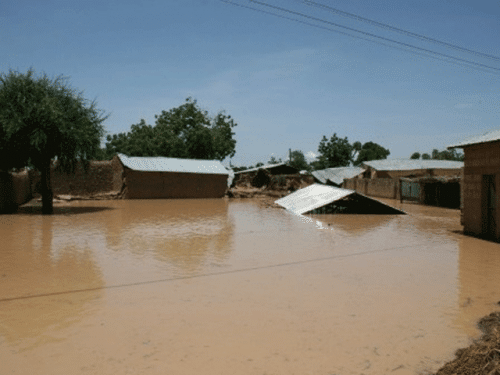Floods considered as one of the most frequently occurring natural disasters are responsible for fatalities globally.
Every year, a geographical area in Nigeria experiences one form of flooding or another.
It has been increasing and a severe problem as it has claimed/damaged properties and displaced people more than any other natural disaster.
The damaging effects of flooding are not limited to the physical ones alone (drowning, property loss, etc.) as there are a lot of health hazards also known to arise from it. This article will discuss the health effects of flooding in Nigeria.
The Nigeria Hydrological Services Agency (NIHSA) are in charge of handling data regarding flooding in Nigeria. They warn states that are on red alert beforehand so they can evacuate the area.
They also warn the surrounding occupants on the health effects of flooding, and you will find out some of them now.
Health Effects of Flooding in Nigeria

When flooding occurs it leaves the victims homeless, destroys properties and even claims lives. However, they are many other health effects of flooding that are very likely to occur.
1. Waterborne diseases and gastro-intestinal diseases infections
Flood water usually carries with it a lot of contaminants ranging from sewage, farm chemicals to refuse, leading to contamination of sources of water.
Water-borne diseases are infectious and endemic and present major primary health concerns following flooding episodes.
These diseases (such as cholera, cryptosporidiosis, diarrhea, rotavirus, typhoid, and paratyphoid) are prevalent after flooding. They say this is a result of the transportation of bacteria parasites and viruses into water systems.
It occurs the highest in areas with poor hygiene or inadequate supply of clean drinking water.
Outbreaks of diarrhea occur even in resource-rich areas, including viral infections like hepatitis A and E, which can be acquired through the fecal-oral route by ingestion of contaminated water and food.
Disposal of all canned/processed and other food materials that come in contact with the floodwater is therefore advised. Other water-borne diseases like conjunctivitis and dermatitis are common as a result of direct contact with polluted water.
2. Rodent-borne (Zoonoses) and Vector-borne diseases
Leptospirosis, a zoonosis causing an acute febrile illness, has increasingly been recognized as a pathogen associated with flooding and extreme weather events.
Outbreaks of leptospirosis have been reported from diverse geographic locations in urban and rural settings, encompassing both the developed and developing world.
Humans can get infected through direct contact with animal hosts (including rodents, domestic pets, and livestock), or an environment contaminated by animal urine.
In flooding, the increase in the transmission is probably multifaceted, with closer contact between animal hosts and humans, direct contamination of floodwaters, and damage to water and sanitation networks.
Other rodent-borne diseases may include Lassa fever, leishmaniasis, plague, Lyme fever, etc.
Diseases that are transmitted by insects/other carriers termed vectors, which include mosquitoes, ticks, fleas, etc. are called vector-borne diseases.
These vectors can carry infective pathogens such as viruses, bacteria, and protozoa, which can be transferred from one host (carrier) to another.
Flooding may indirectly increase the rate of vector-borne disease through an increased number of breeding sites.
It may initially flush out mosquito breeding, but it comes back when the waters recede.
Stagnant water left behind after flooding can act as breeding sites for mosquitoes, and therefore enhance the potential for exposure of the displaced population and emergency workers to infections such as dengue, malaria, and West Nile fever.
3. Respiratory diseases
Respiratory tract infections (RTIs) are not just one of the most common diseases in Nigeria, but are also among the most commonly reported infections after severe flooding due to overcrowding in shelters.
The potentials for respiratory illness arising from inhalation exposure to microbial contaminants during restoration activities is increased.
Exposures to microbial contaminants in agriculture, waste management, and in water-damaged and moldy buildings have been linked to various upper and lower respiratory illnesses and adverse effects including rhinitis, hayfever, toxic pneumonitis (TP), and respiratory infections including pneumonia and initiation of asthma.
4. Skin/eye infection
Traumatized skin is common in patients injured by fast-moving water filled with rock debris, glass, etc. trying to escape floodwaters or cleaning up after floods. Cellulitis and deeper skin infections are subsequently common.
Exposure to floodwater can also increase the risk for throat, ear, and nose problems and conjunctivitis.
The risk of microbial infection is increased with traumatic injury to the skin and also in people with certain underlying conditions such as diabetes, liver cirrhosis, etc.
Staphylococcal and streptococcal bacteria are the most common type of bacterial infection after floodings. Other bacterial infections include mycobacterium and Vibro infections.
Skin rashes can occur from skin contact with sewage-contaminated standing water (usually on the legs).
Tinea corporis is a fungal infection known to occur in warm, humid climates presented by floodwater.
Both typical and atypical fungal infections are increased in the flooding episodes, such as dermatophytosis, blastomycosis, etc.
Contact dermatitis is the skin’s reaction (often in the form of redness, swellings, and itchiness) when it comes in contact with chemicals.
Flood water carries with it chemicals from households, farms and that can cause such a reaction; these include pesticides, detergents, etc.
It could also escalate pre-existing skin conditions such as alopecia areata, eczema, and psoriasis due to a lack of access to daily health care and stress.
5. Wet surface leading to allergies
The after-effect of flooding leaves behind a lot of wet surfaces and a humid environment.
The humid atmosphere is very conducive for allergens such as mold and dust mites, which are known to cause allergic reactions in about 10 – 20% of the population.
This may lead to wheezing, sneezing, runny nose, itchy eyes and coughing depending on the allergy.
6. Electrocution
Electricity is generally considered a significant danger during and after flooding.
Downed electric lines and flooded areas in contact with a power grid could energize the water body around it, creating the chances of electrocution.
Also, electrical appliances in homes in contact with water should be handled carefully as some could store up electric charges enough to give a shock.
7. Insects, amphibians, reptiles and other animals washed ashore
Flooding does not affect humans alone as different habitats are also disturbed by the waters. Termite infestation can increase as a result of flooding.
Furthermore, animal bites (most especially snake bite), scorpion stings, and other arthropods attacks are said to increase as they are washed ashore into residential homes or displaced from their habitat.

Other long-term studies discovered the psychological impacts of flooding of the victims. They included PTSD, depression, anxiety, psychiatric disorders, sleep disorder and suicide.
Collins Nwokolo is a human physiologist, writer and health enthusiast. He loves writing helpful articles on health and fitness, which he enjoys sharing with everyone.






